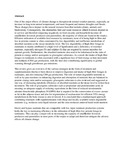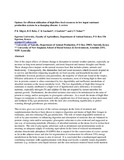| dc.description.abstract | One of the major effects of climate change is disruption in normal weather patterns, especially an increase in long-term annual temperature, and more frequent and intense droughts and floods. These changes have impact on the natural resource base that includes plants, animals and biodiversity. Consequently, this diminishes feed and water resources which livestock depend on to survive and therefore impacting negatively on food security and household incomes of smallholder livestock producers and pastoralists, the majority of whom are found in the tropics. Efficient utilization of available feed resource by ruminants, most of it being high in fibre and low in protein content is often constrained by low digestibility and inefficient metabolism of absorbed nutrients at the tissue metabolic level. The low digestibility of high fibre forage in ruminants is mainly attributed to a high level of lignification and a deficiency of essential nutrients, especially nitrogen (N) and sulphur (S) that are required by rumen microbes for optimal growth. Furthermore, the absorbed nutrients also tend to be imbalanced in the ratio of protein to energy and/or acetogenic to glucogenic substrates. As a result the intake of high fibre forages in ruminants is often associated with a significant loss of feed energy as heat increment and methane (CH4) gas production, with the later also contributing significantly to global warming through greenhouse gas emissions.
This review gives an overview of the various strategies in the form of treatment and supplementation that have been shown to improve digestion and intake of high fibre forages in ruminants, and also reducing CH4 gas production. The role of rumen degradable nutrients as well as by-pass nutrients in enhancing digestion and absorption of nutrients that are balanced in protein: energy ratio and/or acetogenic: glucogenic substrates is also reviewed and suggested as one way of increasing metabolic efficiency of absorbed nutrients at the tissue level to reduce heat increment. The role of glucogenic substrates such as propionate and protein/amino acids in ensuring an adequate supply of reducing equivalents in the form of reduced nicotinamide adenine dinucleotide phosphate (NADPH) that is required for the conservation of excess acetate as fat in the adipose tissue and also for regeneration of oxaloacetate for efficient VFA energy metabolism in the body tissues is also reviewed. It is concluded that a multipronged approach combining treatment with supplementation with cheap and locally available rumen degradable nutrients (e.g. molasses-urea liquid mixture and the urea-molasses-mineral based multi-nutrient block) and bypass nutrients that are compatible with low input ruminant production systems holds the key to increasing efficiency in the utilization of high fibre-low protein forage in ruminants. This can play a major role in increasing the capacity of smallholder livestock producers and pastoralists in most parts of the tropics to adapt and therefore mitigate the adverse effects of climate change. | en_US |


